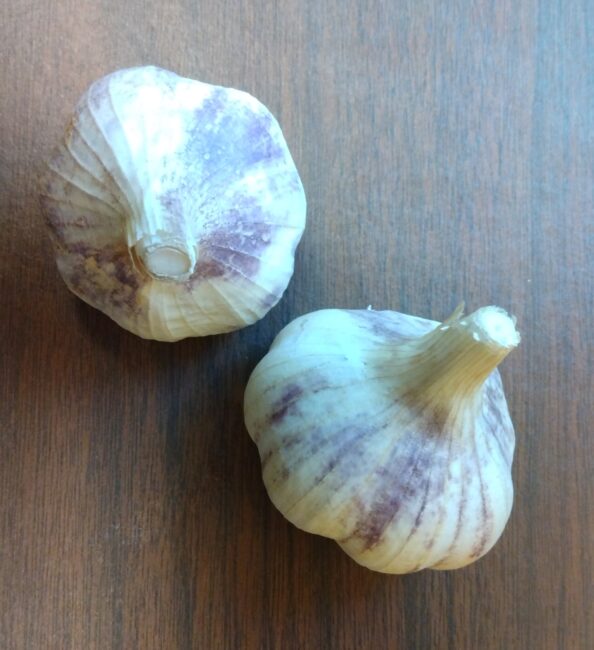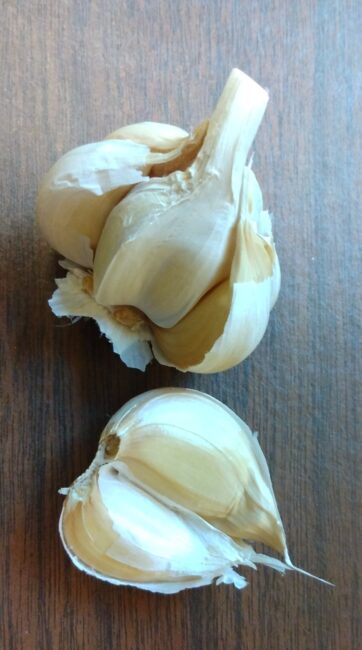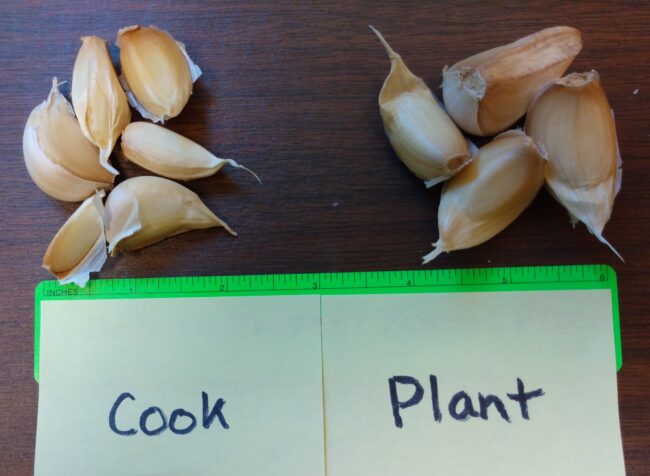
The month of October or even the beginning of November is the best time for planting garlic in the southern part of Wisconsin. The second or third week of October is the usual planting time in northern Wisconsin. We used to plant late in the fall to avoid having cloves sprout. However, new research shows that this growth does not hurt the yield of the plant next year, and that in fact, garlic planted earlier in the fall establishes better and is more productive the next year. Garlic cloves should be planted in full sun, in well-drained soil with a fair amount of organic matter. They generally don’t do well in heavy clay that is poorly drained. My former colleague Horticulture Educator Darrin Kimbler gave a great short video presentation on growing garlic.
There are two major categories of garlic varieties: hardneck and softneck. Hardneck varieties have a milder flavor and survive the cold Wisconsin winters more successfully (these are the only types that can be grown in the northern part of the state). They are called ‘hardneck’ because the base of the flower stalk, called a scape, hardens after harvest, becoming almost woody. They also have only one row of cloves. Softneck varieties have a stronger flavor, and if they do well over the winter, can produce higher yields. They have multiple rows of cloves. Softnecks are typically what you find at the grocery store, not surprisingly, because they are also better for storage. Softneck variety stems can be braided. Many garden centers and catalogs have good selections of both types.

Select large, firm bulbs and break them up into individual cloves. The bigger the clove, the stronger and more productive the resulting plant will be, so you may want to discard (or better yet, cook with) any cloves that are small. Plant the cloves five to eight inches apart and two to four inches deep with the pointy end facing up. The bottom of the clove has a ‘basal plate’ where roots are produced. Some people like to plant in a trench, others dig individual holes; either method is fine. Mulch with about three to four inches of clean straw or marsh hay (in the southern part of the state; use four to six inches in the north) after planting, and water in. If the cloves start to sprout, after the first hard frost, put a thicker coat of mulch on. If you are planting multiple varieties, be sure to label them, with the name as well as whether they are hardneck or softneck. When spring comes, be sure to remove the mulch early so the soil warms and the plants can get started growing right away. Once the leaves start to show, you can re-spread the mulch around the leaves (four inches should be sufficient) to help discourage weeds and retain moisture. In June or July, the hardneck varieties will produce a flower scape (stalk). It will curl around in a loop. The scape should be removed in the ‘curl’ stage since it takes energy from the developing cloves. Some people like to use the scape for making garlic butter or sauteing. If you do let some plants keep the scapes, they will produce tiny bulbils. These can be planted, but will take two seasons to produce garlic bulbs of harvestable size.

You can harvest garlic when the bottom two leaves yellow. This indicates that the bulb is no longer going to grow any larger. Don’t wait too long after this stage to harvest — it is better to harvest too soon than too late. This is because the cloves will start to separate if too mature and won’t store as well. If you are not sure, pull one plant and cut through the bulb to see if the cloves entirely fill their papery wrappers. If a bit loose, they can go a little longer. Leave the roots, stems and leaves on and don’t rinse them at any point. Leave the plants out in a dry space with good air flow to let it wilt down and cure. A mesh screen works really well as a curing surface. Avoid high temperatures (over 90 degrees F) and bright sunlight. Cure for 10-14 days. You will know the curing is complete when the outer skins are dry and crispy, the neck (plant stem) is constricted. Trim off the stems and roots at that time. The bulbs should store for one to three months at room temperature or a little below in cardboard boxes or paper bags. Don’t refrigerate; this may cause the bulbs to start sprouting.
For an article by former UW Horticulture expert Susan Mahr on growing garlic, visit the Wisconsin Horticulture website.




